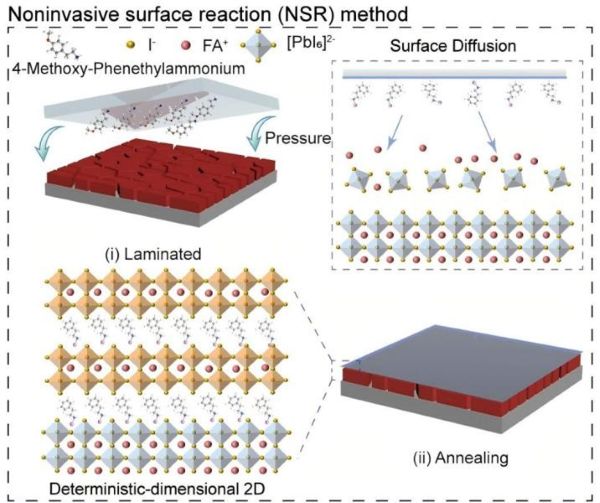Researchers Develop Surface Diffusion Engineering of a 2D Perovskite Layer for Efficient Perovskite Photovoltaics
Prof. SONG Yanlin and Prof. WANG Yang’s group at the Institute of Chemistry, Chinese Academy of Sciences, and Prof. ZHOU Huanping from Peking university, has developed a method to improve the performance and stability of perovskite solar cells (PSCs)---novel surface diffusion engineering technique. This method could fabricate phase-pure 2D perovskite passivation layers with precisely controlled structure at the interface between the light-absorbing layer and the charge transport layer.
Perovskite solar cells (PSCs) have attracted global attention for their high-power conversion efficiency and low fabrication cost. A promising approach to enhance PSCs’ performance including combining 3D perovskites with 2D perovskite layers, which can help stabilize the interface. However, conventional liquid-based methods often produce disordered 2D layers with mixed compositions, leading to inefficient charge extraction and limited device stability.
To tackle this issue, the team introduced a solvent-free, solid-state reaction strategy called the Noninvasive Surface Reaction (NSR) strategy, which differs from conventional solution-based methods. Addressing the challenge of mixed-dimensional (n = 1, 2, 3, etc.) formation. Resulting a pure-phase 2D perovskite contact layer with a well-defined dimensionality on top of the 3D perovskite.
This approach proved highly reproducible and scalable—researchers successfully fabricated high-quality perovskite films as large as 10 cm × 10 cm. They also tested seven types of organic cations(including HABr, BABr, PEAI, OAI, HAI, BAI, and 4-MeO-PEAI) to construct phase-pure 2D perovskite contact interfaces, demonstrating the broad applicability of the method.
Furthermore, the solar cells fabricated using this technique achieved a remarkable power conversion efficiency of 26.13% (certified 25.66%), and retained full performance after 1,200 hours of continuous operation. A larger mini-module also reached 23.03% efficiency (certified 22.32%) and showed excellent operational durability.
“Our noninvasive surface reaction (NSR) strategy provides a robust, universal pathway for constructing well-defined 2D perovskite contact layers through solid-state diffusion, paving the way for more efficient and stable perovskite optoelectronics,” said Prof. SONG Yanlin.
This study was published in Nature Synthesis.

Phase-Pure 2D perovskite passivation via solid-state reaction (Image by ZHANG Kun)
Contact:
Prof. SONG Yanlin; Prof. WANG Yang
Institute of Chemistry, Chinese Academy of Sciences
Prof. ZHOU Huanping
Peking University
Email: ylsong@iccas.ac.cn; wangyang@iccas.ac.cn; hpzhou@pku.edu.cn





